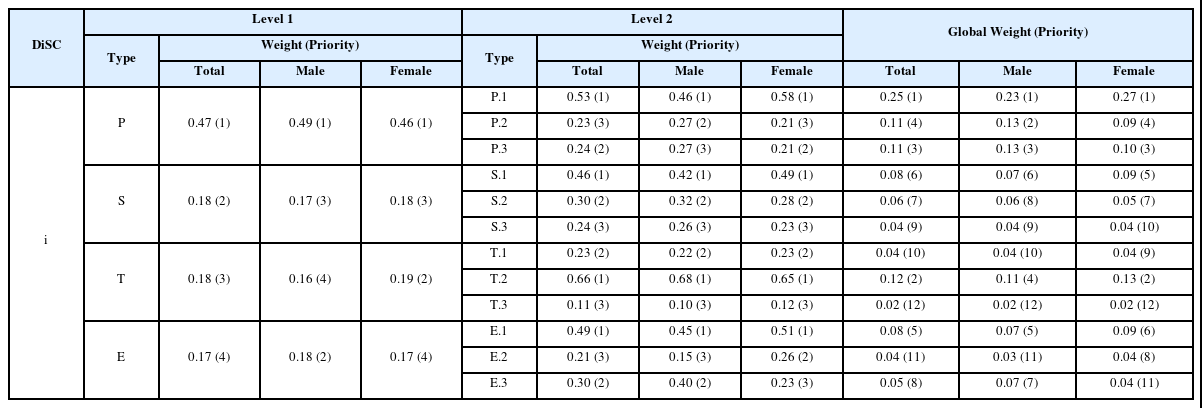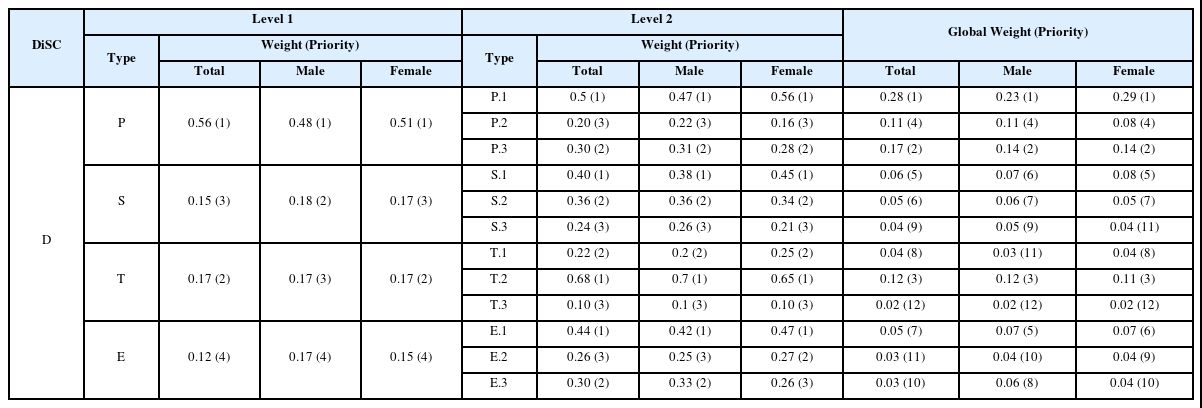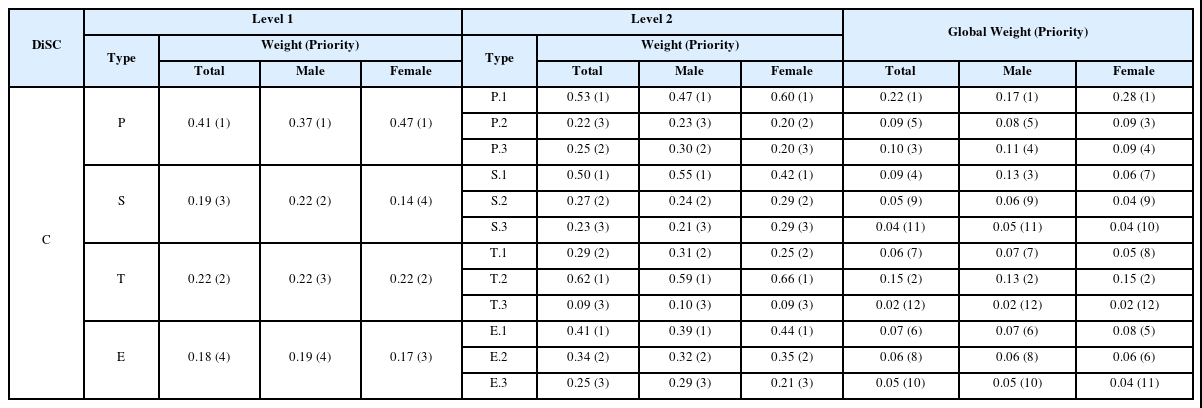DiSC 성격유형이 사전대피행동에 미치는 영향
Influence of DiSC Personality Traits on Pre-evacuation Behavior
Article information
Abstract
사전대피행동이 피난소요시간에 미치는 영향에도 불구하고, 사전대피행동을 정량화하기 위한 연구는 여전히 부족하다. 본 연구에서는 이러한 한계점을 개선하기 위한 기초연구로서 설문조사를 통해 개인의 성격이 사전대피행동에 미치는 영향을 분석하고자 한다. 이를 위해 312명의 응답자를 대상으로 DiSC 성격유형을 조사하고, analytic hierarchy process (AHP) 분석을 통해 성격유형에 따른 사전대피행동의 우선순위를 분석하였다. 그 결과 i형 성격유형은 다른 사람들을 따라 대피하는 행동의 우선순위가 높게 나타났으며, S형 성격유형은 즉시 대피하는 행동의 우선순위가 높게 나타났다. 또한 C형 성격유형은 화재정보를 탐색하는 행동의 우선순위가 높게 나타났으며, 성별에 따라 남성은 정보를 탐색하는 행동, 여성은 정보를 전달하는 행동에 높은 우선순위를 보였다. 최종적으로 본 논문에서는 도출된 성격유형과 성별에 따른 사전대피행동의 우선순위를 피난계획 수립 시 임무 부여에 활용할 수 있는 방법을 제안한다.
Trans Abstract
Although the effect of pre-evacuation behavior on evacuation time is known, studies to quantify pre-evacuation behavior are insufficient. To address this gap in the literature, this study analyzed the impact of personality traits on pre-evacuation behavior through a questionnaire survey. First, the DiSC personality trait type was analyzed for 312 people, and pre- evacuation behavior according to the DiSC personality trait type was analyzed using the analytic hierarchy process (AHP) questionnaire. The i-type prioritized evacuating along with others, S-type preferred evacuating immediately, whereas C-type showed a high priority for actions after searching for information. Moreover, males exhibited high information-seeking behaviors, whereas females showed information-transmitting behaviors. Finally, this study devised a method using personality- and gender-based pre-evacuation behavior in the division of duties among employees while establishing an evacuation plan.
1. 서 론
건축물 화재 시 재실자의 안전한 대피는 피난허용시간(available safe egress time, ASET)과 피난소요시간(required safe egress time, RSET)에 의해 결정되며, ASET이 RSET보다 클 때 안전한 대피가 가능하다. RSET은 건축물의 구조, 재실자의 대피행동 등에 영향을 받으며, 화재감지시간, 사전대피시간, 대피시간으로 구분된다(1). 이때 사전대피시간은 화재경보기, 타인의 경고, 연기 등을 통해 재실자가 화재를 인지하는 시간부터 대피를 시작할 때까지의 시간을 의미하며, 화재정보 파악, 의사소통, 소지품 정리 등과 같은 재실자의 사전대피행동에 영향을 받는다. 사전대피시간은 개인의 성격과 주변 환경 등에 의해 지연될 수 있기 때문에 RSET에서 매우 큰 비중을 차지한다(2,3). 하지만 사전대피시간이 RSET에 미치는 영향에도 불구하고, 사전대피행동을 정량화하기 위한 연구는 여전히 부족하다(3,4).
이에 본 연구에서는 사전대피행동을 정량화하기 위한 기초연구로서 설문조사를 통해 개인의 성격이 사전대피행동에 미치는 영향을 분석하고자 한다. 이를 위해, 312명의 응답자를 대상으로 DiSC 성격유형을 조사하고, analytic hierarchy process (AHP) 분석을 통해 성별과 성격유형에 따른 사전대피행동의 우선순위를 분석하였다. 최종적으로 도출된 성격유형과 성별에 따른 사전대피행동의 우선순위를 피난계획 수립 시 임무 부여에 활용할 수 있는 방법을 제안한다.
2. 선행연구 고찰
2.1 DiSC 성격유형
전 세계적으로 가장 널리 사용되는 성격 척도 중 하나인 DiSC 성격유형은 개인의 표면적인 성격유형을 Table 1과 같이 4가지 유형으로 식별하고 이해할 수 있다고 설명한다(5).
DiSC 성격유형은 ‘외향적과 내향적’, ‘과업 지향적과 사람 지향적’을 기준으로 D형, i형, S형, C형으로 구분되며, 각 성격유형은 서로 다른 행동 특성, 인간관계 특성, 커뮤니케이션 특성을 가진다. D형 성격유형은 자신감이 있고, 목표 달성에 중점을 두며, i형 성격유형은 개방적이며, 사람 간의 관계를 강조하는 특성을 가진다. S형 성격유형은 신뢰, 협력과 성실을 강조하며, C형 성격유형은 분석적이고 계획적이기 때문에, 정확성, 전문성 및 역량을 강조한다.
2.2 AHP 분석을 위한 사전대피행동의 계층구조
사전대피행동의 우선순위를 분석하기 위해 본 논문에서는 analytic hierarchy process (AHP) 분석을 활용하였다(6). AHP 분석은 쌍대비교를 통해 의사결정의 전 과정을 계층화하고 각 구성요소의 중요도와 우선순위를 판단할 때 사용되는 분석 방법으로 5단계의 절차로 이루어진다.
가장 먼저 1단계에서 문제를 정의하고 목표를 결정한 후 2단계로 구성요소의 수준(level)에 따라 계층구조를 개발한다. 이후 3단계로 각 구성요소에 대한 쌍대비교를 실시하고, 4단계로 일관성 검사를 수행한 후, 마지막 5단계로 각 수준에서 구성요소의 상대적 가중치 및 우선순위를 결정한다.
사전대피행동의 우선순위 분석을 위한 계층구조는 선행연구(7,8)의 결과를 바탕으로 Figure 1과 같이 개발되었다. 사전대피행동의 level 1은 ‘대피준비’, ‘정보탐색’, ‘정보전달’, ‘대피’로 구분되었으며, ‘대피준비’에는 현재 작업 종료, 개인 소지품 수집 및 기존 행동(화재 알람이 울리기 전과 동일한 행동)이 포함된다. ‘정보탐색’은 스스로 화재를 조사하고 주변 상황을 살피며 주변 사람들과 의논하는 행동과 같이 화재에 대한 정보를 거주자가 스스로 찾는 행동을 포함한다. ‘정보전달’은 화재 알람을 주변 사람들에게 알리고, 다른 사람에게 전화를 걸거나, 소방서에 화재를 신고하는 행동을 포함하며, 마지막으로 ‘대피’는 스스로 대피하는 행동, 다른 사람과 함께 대피하는 행동, 다른 사람을 뒤따라 대피하는 행동을 포함한다.
3. 설문조사 방법 및 결과
3.1 설문조사의 개요 및 분석 방법
사전대피행동은 연령(9), 학력(10), 소속(9)에 영향을 받기 때문에 설문 응답자는 20대 대학생으로 한정하였다. 설문조사는 2개월간 온라인으로 진행되었으며, 모든 응답자는 연구에 대한 설명을 읽고 참여동의서에 서명한 후 설문에 참여하였다.
설문문항은 DiSC 성격유형을 분석하기 위한 28문항과 사전대피행동의 우선순위를 분석하기 위한 AHP 설문 18문항(level 1: 6문항, level 2: 12문항)으로 구성되었으며, 이때 AHP 설문에는 9점 척도가 사용되었다.
결과분석은 DiSC 성격유형에 따라 응답자를 4개의 그룹으로 구분하고, 각 그룹의 사전대피행동 우선순위를 AHP 분석을 통해 분석하는 순서로 진행되었다. AHP 분석에서 일관성 비율이 0.2 이상인 참여자는 데이터 분석에서 제외되었으며, 최종적으로 결과분석에 활용된 응답자 312명의 성별과 DiSC 성격유형은 Table 2와 같다.
3.2 성격유형에 따른 설문조사 결과
DiSC 성격유형과 성별에 따른 사전대피행동의 가중치와 우선순위는 다음과 같다(Tables 3~6).

The Weight and Priorities of the Pre-evacuation Behaviour of the Respondents with Type i Personality
D형 응답자의 성별에 따른 우선순위를 살펴보면, 성별에 따라 level 1에서 가장 높은 우선순위와 가장 낮은 우선순위를 보이는 행동은 동일하게 나타났으며, 2순위, 3순위 행동은 성별에 따라 유사한 가중치(weight)를 보였다. 전체 우선순위(global priority)의 경우, 1순위부터 4순위까지 남성과 여성이 동일하게 나타났다(Table 3).
i형 응답자 99명의 분석 결과를 살펴보면, level 1에서 ‘대피준비(P)’ 행동의 우선순위가 가장 높게 나타났으며, ‘정보탐색(S)’, ‘정보전달(T)’, ‘대피(E)’ 순으로 높은 우선순위를 보였다. 전체 우선순위의 경우 ‘P.1’, ‘T.2’, ‘P.3’ 순으로 높은 우선순위를 보였으며, ‘S.3’, ‘T.1’, ‘E.2’, ‘T.3’ 행동은 낮은 우선순위를 보였다. 성별에 따라 남성과 여성 모두 ‘대피준비(P)’ 행동의 우선순위가 가장 높게 나타났다. 그러나 두 번째 우선순위의 경우 남성은 ‘대피(E)’, 여성은 ‘정보전달(T)’로 나타났다. 전체 우선순위에서 가장 높은 우선순위와 가장 낮은 우선순위를 보인 행동은 성별에 따라 동일하게 나타났다(Table 4).
S형 응답자의 경우 level 1에서 ‘대피준비(P)’ 행동의 우선순위가 가장 높게 나타났으며, ‘정보전달(T)’, ‘대피(E)’, ‘정보탐색(S)’ 순으로 높은 우선순위를 보였다. 전체 우선순위의 경우 ‘P.1’, ‘T.2’, ‘P.3’ 순으로 높은 우선순위를 보였다. 남녀 모두 ‘대피준비(P)’ 행동의 우선순위가 가장 높게 나타났으며, ‘정보탐색(S)’ 행동의 우선순위가 가장 낮게 나타났다. 전체 우선순위에서 남녀의 1순위, 2순위, 12순위는 동일하게 나타났다(Table 5).
C형 응답자의 경우 level 1에서 ‘대피준비(P)’ 행동의 우선순위가 가장 높게 나타났으며, ‘정보전달(T)’, ‘정보탐색(S)’, ‘대피(E)’ 순으로 높은 우선순위를 보였다. level 2에서 ‘P.1’, ‘T.2’, ‘P.3’ 순으로 높은 우선순위를 보였으며, ‘S.2’, ‘E.3’, ‘S.3’, ‘T.3’ 행동에 대해 낮은 우선순위를 보였다. 남녀 모두 ‘대피준비(P)’ 행동의 우선순위가 가장 높았으며, 전체 우선순위에서 남녀의 1순위, 2순위, 12순위는 동일하게 나타났다(Table 6).
4. 성격유형과 성별에 따른 사전대피행동 우선순위 분석과 활용방안
4.1 성격유형과 성별에 따른 사전대피행동 우선순위 분석
성격유형과 성별에 따른 사전대피행동 우선순위 분석 결과를 요약하면 Table 7과 같다.
level 1에서 모든 성격유형에서 가장 높은 우선순위를 보인 행동은 ‘대피준비(P)’로 나타났으며, level 2에서 가장 높은 우선순위를 보인 행동은 ‘기존 행동을 유지(P.1)’로 나타났다. 이러한 결과는 재실자가 화재 알람을 듣고 대피하지 않고 기존 행동을 유지하는 비율이 높다는 것을 의미하며, 이러한 현상은 빈번한 비화재보로 인한 ‘crying wolf effect’에 의한 것으로 판단된다(11-13).
성격에 따른 level 1의 우선순위를 살펴보면, D형, S형, C형 성격유형의 경우 ‘정보전달(T)’ 행동의 우선순위가 두 번째로 높게 나타났으며, i형 성격유형의 경우 ‘정보탐색(S)’ 행동의 우선순위가 두 번째로 높게 나타났다. 또한 S형 성격유형은 ‘대피(E)’ 행동의 우선순위가 세 번째로 높게 나타났다. 이러한 결과는 안전을 선호하는 S형 성격유형의 특성을 반영한 것으로 판단된다.
D형 성격의 경우 남성은 ‘정보탐색(S)’ 행동의 우선순위가 두 번째로 높게 나타났으며, 여성은 ‘정보전달(T)’ 행동의 우선순위가 두 번째로 높게 나타났다. 또한, 남녀 모두 ‘대피(E)’ 행동에 대한 우선순위가 가장 낮은 것으로 나타났다. 이는 D형 성격유형을 가진 사람들이 즉시 대피하는 것보다 정보탐색과 정보전달과 관련된 행동에 더 높은 우선순위를 보인다는 것을 의미한다. 이러한 경향은 분석적이고 계획적인 성격을 보이는 C형 성격유형에서도 유사하게 나타난다. 두 가지 성격유형의 ‘과업 지향적’인 특성으로 인해 정보탐색과 정보전달 행동의 우선순위가 즉각적인 대피 행동보다 높은 것으로 판단된다. 그러나 성별에 따라 정보탐색과 정보전달 행동의 우선순위가 다르며, 남성은 정보탐색, 여성은 정보전달 행동을 우선시하는 것으로 나타났으며, 이러한 경향은 모든 성격유형에서 동일하게 나타났다. 즉, ‘정보전달’ 행동에 대한 여성의 높은 우선순위는 성격보다는 성별에 영향을 받은 것으로 판단된다.
성격에 따른 level 2의 우선순위를 살펴보면, i형 성격유형은 ‘사람 지향적’ 특성으로 인해 다른 성격유형에 비해 ‘다른 사람과 함께 대피(E.2)’, ‘다른 사람을 따라 대피(E.3)’ 행동의 우선순위가 높게 나타났다. 또한 S형 성격유형은 모험을 싫어하고 안정된 상황을 추구하는 성격특성으로 인해 다른 성격유형에 비해 ‘혼자 대피(E.1)’ 행동의 우선순위가 높게 나타났다. C형 성격유형은 신중하고 체계적인 성격특성으로 인해 ‘스스로 화재를 탐색(S.1)’ 행동의 우선순위가 높게 나타났으며, 이러한 경향은 여성보다 남성이 더 높은 것으로 나타났다.
4.2 성격유형과 성별에 따른 사전대피행동 우선순위 활용방안
설문조사의 결과는 성별과 DiSC 성격유형에 따라 사전대피행동의 우선순위가 다르다는 사실을 보여준다. 본 논문에서는 성격에 따른 행동우선순위의 차이를 「화재의 예방 및 안전관리에 관한 법률」 제36조에 따른 피난계획 수립과 동법 제24조에 따라 특정소방대상물의 소방안전관리자가 수립하여야 하는 소방계획서 작성에 활용할 수 있는 방법을 제안하고자 한다.
건물 대피 시 재실자의 행동은 그룹의 리더와 주변 사람들의 행동에 영향을 받기 때문에(14,15), 대피 시 직원의 임무는 매우 중요하다. 하지만 선행연구에 따르면 대피상황에서 직원들이 피난계획과 달리 재실자를 즉시 대피시키지 않는 현상이 관찰되어왔다(16).
본 연구의 결과를 반영하여 직원의 성별과 성격유형에 따른 행동우선순위를 고려하여 피난계획을 수립하고 임무를 부여하는 경우 직원의 임무 수행 효율성을 높일 수 있을 것으로 기대된다.
구체적인 예로 S형 성격유형은 다른 성격유형에 비해 ‘대피(E)’, ‘건물 내 사람들에게 알리기(T.2)’, ‘사람과 함께 대피(E.2)’ 행동에 높은 우선순위를 보이기 때문에, S형 성격유형의 직원은 사람과 함께 대피하는 리더 임무에 가장 적합할 수 있다. 또한 C형 성격유형은 다른 성격유형에 비해 ‘스스로 화재 조사(S.1)’ 행동에 대한 우선순위가 높게 나타났기 때문에 화재 발생 여부를 식별하는 임무를 부여하는 것이 적합할 수 있다. 또한 남성이 여성보다 ‘정보탐색(S)’의 우선순위가 높게 나타났으므로 정보탐색의 임무는 남성에게 더 적합할 수 있으며, 여성이 남성보다 ‘정보전달(T)’ 행동에 대한 우선순위가 높게 나타났으므로 사람들에게 정보를 전달하는 임무는 여성에게 더 적합할 수 있다.
5. 결 론
본 연구에서는 설문조사를 통해 성별과 성격유형에 따른 사전대피행동 우선순위를 분석하였다. 그 결과 i형 성격유형은 다른 사람과 함께 대피하는 행동의 우선순위가 높게 나타났다. S형 성격유형은 즉시 대피하는 행동의 우선순위가 가장 높았으며, C형 성격유형은 정보를 탐색하는 행동의 우선순위가 높게 나타났다. 또한 남성은 정보를 찾는 행동의 우선순위가 높게 나타났으며, 여성은 다른 사람에게 정보를 전달하는 행동의 우선순위가 높은 것으로 나타났다.
이러한 연구의 결과는 피난계획 수립 시 직원들의 임무 부여에 활용할 수 있을 것으로 기대된다. 구체적으로 S형 성격유형의 직원은 사람들과 함께 대피하는 리더의 임무, C형 성격유형은 화재에 대한 정보를 탐색하는 임무에 적합할 수 있다. 또한 남성은 정보를 탐색하는 임무, 여성은 정보를 전달하는 임무를 부여하였을 때 각 임무의 효율성을 높일 수 있을 것으로 기대된다.
본 논문은 사전대피행동과 성격의 관계를 분석한 최초의 논문이라는 점에서 큰 의미를 가진다. 하지만 본 논문은 312명의 20대만을 대상으로 설문조사를 실시하였기 때문에, 부족한 응답자 수와 한정된 응답자 연령분포는 본 논문의 한계점이다. 향후 이러한 한계점을 개선하기 위해, 다양한 연령의 응답자를 대상으로 추가 설문 및 분석이 이루어져야 할 것으로 판단되며, 이후 대피 실험을 통해 본 논문에서 제시하는 임무 부여 방안의 효율성을 검증한다면, 피난계획수립 및 직원 임무 부여의 근거자료로 활용될 수 있을 것으로 판단된다.
후 기
본 논문은 제 2저자의 석사학위논문(17)에 포함된 설문조사를 재분석하여 작성되었음. 이 논문은 2019학년도 부경대학교 연구년[Ⅱ] 교원 지원사업에 의하여 연구되었음.






